Lowrance electronic LVR-250 User Manual
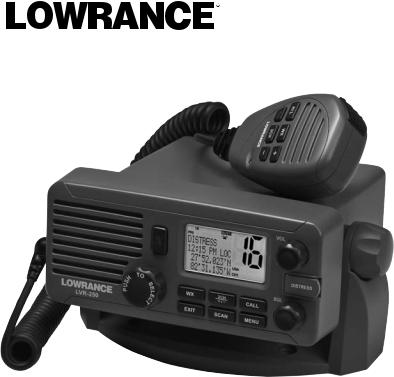
Pub. 988-0158-051
www.lowrance.com
LVR-250
VHF Radio
Installation and Operation
Instructions

Copyright © 2008 Navico
All rights reserved.
Lowrance® is a registered trademark of Navico
No part of this manual may be copied, reproduced, republished, transmitted or distributed for any purpose, without prior written consent of Lowrance Electronics.
Any unauthorized commercial distribution of this manual is strictly prohibited.
Lowrance Electronics may find it necessary to change or end our policies, regulations, and special offers at any time. We reserve the right to do so without notice. All features and specifications subject to change without notice. All screens in this manual are simulated. On the cover: LVR-250 shown. Other models covered in the manual are similar.
For free owner’s manuals and the most current information on this product, its operation and accessories, visit our web site: www.lowrance.com
Lowrance Electronics
12000 E. Skelly Dr.
Tulsa, OK USA 74128-2486
Printed in China.
Important safety information
Please read carefully before installation and use.
|
|
|
This is the safety alert symbol. It is used to alert you to potential |
|
DANGER |
|
|
|
|
personal injury hazards, Obey all safety messages that follow this |
|
|
|
|
symbol to avoid possible injury or death. |
|
|
|
|
|
|
|
WARNING indicates a potentially hazardous situation which, if not |
|
WARNING |
|
|
|
|
avoided, could result in death or serious injury |
|
|
|
|
|
|
|
|
|
|
|
|
CAUTION indicates a potentially hazardous situation which, if not |
|
CAUTION |
|
|
|
|
avoided, could result in minor or moderate injury. |
|
|
|
|
|
|
|
|
|
|
|
|
CAUTION used without the safety alert symbol indicates a po- |
|
CAUTION |
|
|
|
|
tentially hazardous situation which, if not avoided, may result in |
|
|
|
|
property damage. |
|
|
|
|

Table of Contents |
|
Installation......................................................................................................... |
6 |
Installation Options................................................................................................................................... |
6 |
Location Requirements............................................................................................................................ |
6 |
Checklist........................................................................................................................................................ |
7 |
Gimbal Installation.................................................................................................................................... |
8 |
Change the Viewing Angle..................................................................................................................... |
8 |
Recessed Installation................................................................................................................................ |
8 |
Install the Microphone Bulkhead Mount.......................................................................................... |
9 |
Fix the DSC label...................................................................................................................................... |
10 |
Connect the Radio Cables.................................................................................................................... |
10 |
Set Up the Radio...................................................................................................................................... |
11 |
Enter Your User MMSI............................................................................................................................ |
11 |
The Completed Installation................................................................................................................. |
12 |
Notes:........................................................................................................................................................... |
13 |
Section 1 - General Information...................................................................... |
14 |
1-1 Features............................................................................................................................................... |
14 |
1-2 Customizing your Lowrance VHF Radio.................................................................................. |
15 |
1-3 How to Display and Navigate Menus....................................................................................... |
15 |
1-4 How to Enter Alphanumeric Data.............................................................................................. |
15 |
1-5 LCD Symbols and Meanings ....................................................................................................... |
15 |
1-6 Basic Operation and Key Functions.......................................................................................... |
17 |
Section 2 - The Radio Menu (MENU)................................................................. |
20 |
2-1 Radio Menu Options (Menu) ...................................................................................................... |
20 |
2-2 Maintain Your Buddy List (BUDDY LIST).................................................................................. |
21 |
2-2-1 Add an Entry..................................................................................................................................................... |
21 |
2-2-2 Edit an Entry...................................................................................................................................................... |
21 |
2-2-3 Delete an Entry............................................................................................................................................... |
22 |
2-3 Local or Distance Sensitivity (LOCAL/DIST)............................................................................ |
22 |
2-3-1 Set Distance Sensitivity.............................................................................................................................. |
22 |
2-3-2 Set Local Sensitivity...................................................................................................................................... |
22 |
2-4 Backlighting (BACKLIGHT) and Contrast (CONTRAST)...................................................... |
22 |
2-4-1 Set the Backlighting Level........................................................................................................................ |
23 |
2.4.2 Set the Contrast Level.................................................................................................................................. |
23 |
Lowrance - LVR-250 Installation and Operation Instructions |
3 |
2-5 GPS Data and Time (GPS/DATA).................................................................................................. |
23 |
2-5-1 Manually Enter Position and UTC Time (MANUAL)................................................................... |
23 |
2-5-2 Local Time (TIME OFFSET)........................................................................................................................ |
24 |
2-5-3 Time Format Options (TIME FORMAT).............................................................................................. |
24 |
2-5-4 Time Display Options (TIME DISPLAY).............................................................................................. |
25 |
2-5-5 Position Display Options (LL display)................................................................................................ |
25 |
2-5-6 Course & Speed Display Options (COG/SOG).............................................................................. |
25 |
2-5-7 GPS Alert Options (ALERT) ..................................................................................................................... |
26 |
2-6 GPS Simulator (SIMULATOR)........................................................................................................ |
26 |
2-7 Reset to Factory Defaults (RESET).............................................................................................. |
26 |
Section 3 - Radio Setup Menu (RADIO SETUP)................................................. |
27 |
3-1 Radio Setup Menu (RADIO SETUP)............................................................................................ |
27 |
3-2 Channel (UIC).................................................................................................................................... |
27 |
3-3 Channel Names (CH NAME)........................................................................................................ |
28 |
3-4 RING & BEEP Volume (RING VOLUME) and (KEY BEEP)...................................................... |
28 |
3-5 Internal Speaker Connections (INT SPEAKER)....................................................................... |
28 |
3-6 Set the Priority Channel (WATCH MODE)................................................................................ |
29 |
3-7 Weather Alert (Wx ALERT) ........................................................................................................... |
29 |
3-8 NMEA protocol (COM PORT)....................................................................................................... |
29 |
Section 4 - DSC Setup Menu (DSC SETUP)........................................................ |
30 |
4-1 DSC Setup - Menu Options.......................................................................................................... |
30 |
4-2 Enter Your USER MMSI (USER MMSI)......................................................................................... |
30 |
4-3 Maintain Your Groups (GROUP SETUP).................................................................................... |
31 |
4-3-1 Create a Group (GROUP SETUP)........................................................................................................... |
31 |
4-3-2 Edit Group Name Details ......................................................................................................................... |
31 |
4-3-3 Delete a Group................................................................................................................................................ |
32 |
4-4 Response to Individual Calls (INDIV REPLY)........................................................................... |
32 |
4-5 ATIS MMSI & ATIS Functionality.................................................................................................. |
32 |
4-5-1 Enter or Edit YOUR ATIS MMSI................................................................................................................ |
33 |
4-5-2 Enable ATIS Functionality (ATIS FUNC) LVR-250 EU ONLY.................................................... |
33 |
4-6 DSC functionality options (DSC FUNC).................................................................................... |
34 |
4-7 Response Type to LL Polling Calls (LL REPLY)........................................................................ |
34 |
Section 5 - Sending and Receiving DSC Calls................................................... |
35 |
5-1 What is DSC?...................................................................................................................................... |
35 |
5-2 Sending DSC calls............................................................................................................................ |
35 |
5-2-1 Make a Routine Call (Individual)........................................................................................................... |
36 |
5-2-2 Retrying a Routine Call............................................................................................................................... |
36 |
4 |
Lowrance - LVR-250 Installation and Operation Instructions |
5-2-3 Acknowledgement of an Individual Incoming Call (INDIV) |
................................................37 |
5-2-4 Recall the Most Recent Incoming Call (LAST).............................................................................. |
37 |
5-2-5 Call a Group (GROUP).................................................................................................................................. |
37 |
5-2-6 Call All Ships (ALL SHIPS)........................................................................................................................... |
38 |
5-2-7 Call using the Call Log (CALL LOG)..................................................................................................... |
38 |
5-2-8 Call using the Distress Log (DIST LOG)............................................................................................. |
39 |
5-2-9 Call distress relay using the Distress Log (DIST LOG)............................................................... |
39 |
5-2-10 Request the LL Position of a Buddy (LL REQUEST)................................................................. |
40 |
5-3 Receiving DSC Calls......................................................................................................................... |
41 |
5-3-1 Receiving an All Ships Call (ALL SHIPS)............................................................................................ |
41 |
5-3-2 Receiving an Individual Call (INDIV)................................................................................................... |
41 |
5-3-3 Receiving a Group Call (GROUP).......................................................................................................... |
42 |
5-3-4 Receiving a Geographic Call (GEOGRAPH).................................................................................... |
42 |
5-3-5 Receiving a Polled Position Call (POSITION).................................................................................. |
42 |
Section 6 - Distress Calls................................................................................... |
43 |
6-1 Sending a Distress Call................................................................................................................... |
43 |
6-2 Receiving a Distress Call (DISTRESS!)........................................................................................ |
44 |
6-3 Distress Acknowledgement (distress ack) or Relay ...................................................... |
44 |
Appendix A - Technical Specifications............................................................. |
45 |
Appendix B - Troubleshooting......................................................................... |
47 |
Appendix C - VHF Marine Channel Charts...................................................... |
48 |
C-1 International Channel Chart........................................................................................................ |
48 |
Special Notes on International Channel Usage....................................................................................... |
49 |
C-2 USA Channel Chart......................................................................................................................... |
50 |
Special Notes on USA Channel Usage........................................................................................................... |
51 |
C-3 CANADA Channel Chart................................................................................................................ |
52 |
Special Notes on Canada Channel Usage................................................................................................... |
53 |
C-4 WEATHER Channels........................................................................................................................ |
54 |
Appendix D - EU Inland Waterway Channels ................................................. |
55 |
D-1 Special Channels 2 ......................................................................................................................... |
58 |
Appendix E - MMSI and License Information................................................... |
59 |
FCC Compliance.......................................................................................................................................................... |
59 |
Navico Full Two-Year Lowrance VHF Warranty............................................... |
60 |
How to Obtain Service ..................................................................................... |
61 |
Lowrance - LVR-250 Installation and Operation Instructions |
5 |
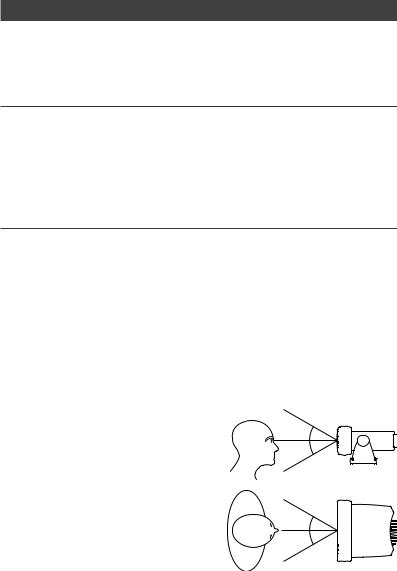
Installation
This Lowrance radio is designed to generate a digital maritime distress call to facilitate search and rescue. To be effective as a safety device, this radio must be used only within the geographic range of a shore-based VHF marine Channel 70 distress and safety watch system. The geographic range may vary but under normal conditions is approximately 20 nautical miles.
Installation Options
There are two ways to install the radio. You can choose:
•A deck or overhead mounted gimbal installation. The reversible mounting gimbal is fixed to a suitable site and the radio is placed into it. The radio can be removed for storage and the viewing angle can be adjusted.
•A recessed installation. The radio is recessed into a cavity cut into a bulkhead. The radio fixture is permanent and the viewing angle cannot be adjusted.
Location Requirements
Please check these before doing any cutting or drilling.
Whichever installation method you choose, ensure that the chosen location:
• Is at least 3’ (1 m) from the antenna
•Allows easy connection to (at least) a 10 Amp fused 13.6 V DC electrical source and the antenna
•Is at least 1.5’ (45 cms) from the compass to avoid creating magnetic deviation of the compass during radio operation
•Has a suitable space close by for installing the microphone bulkhead mount
•Provides easy access to the controls on the front panel
•Provides reasonable access to the wiring at the
back of the radio Side
•Provides enough room to fix the DSC warning label
The VHF has a large LCD screen with an optimum viewing angle of approx. +/-20 deg. Ensure the chosen location provides a suitable view of the display. Ideally, the user should be directly in front of the display or no more than +/-20 deg from the front of the display.
Note: If unsure, temporarily power up the radio and check for a suitable location.
20˚
20˚
Top
20˚
20˚
6 |
Lowrance - LVR-250 Installation and Operation Instructions |
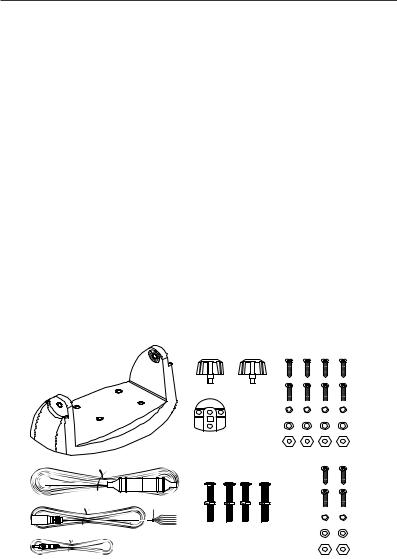
Checklist
The following items should be supplied in the box. Check before starting the installation and contact your dealer if an item is missing.
Note: An antenna is not provided. Consult your Lowrance dealer for advice if necessary.
1.Mounting gimbal for the VHF radio
2.Power supply cable with in built 7 Amp fuse
3.External speaker connection cable with white (+) wire and black (-) wire
4.GPS connection cable
5.Two mounting knobs
6.Microphone bulkhead mount
7.Four self-tapping screws for the mounting gimbal
8.Four flat screws for the mounting gimbal
9.Four spring washers for the mounting gimbal
12.Two self-tapping screws for the microphone bulkhead mount
13.Two flat screws for the microphone bulkhead mount
14.Two spring washers for the microphone bulkhead mount
15.Two plain washers for the microphone bulkhead mount
16.Two nuts for the microphone bulkhead mount
17.Four M5x32 screws for recessed installation
18.Four nuts for the recessed installation
Not pictured: Two plastic stoppers for the recessed installation. Installation template.
10.Four plain washers for the mounting gimbal
11.Four nuts for the mounting gimbal
One 7 Amp spare fuse in case of accidental reverse of battery polarity. Base unit and microphone. Protective cover.
1 |
5 |
7 |
|
|
|
|
6 |
8 |
|
9 |
|
|
|
|
|
|
10 |
|
|
11 |
2 |
17 |
|
12 |
|
|
||
|
|
|
|
3 |
|
18 |
13 |
|
|
||
4 |
|
|
14 |
|
|
15 |
|
|
|
|
|
|
|
|
16 |
Lowrance - LVR-250 Installation and Operation Instructions |
7 |
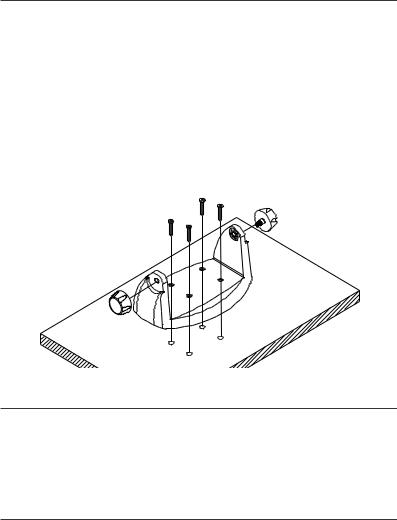
Gimbal Installation
1.Hold the mounting gimbal at the chosen location and use a soft pencil to mark the screw hole positions onto the mounting surface.
2.If you can’t reach behind the mounting surface to attach the nuts, use the self-tapping screws instead of the flat screws shown in the picture. If you’re drilling into fibreglass, use a drill bit smaller than 3/16” (5mm) to drill the pilot holes.
Otherwise, drill the four screw holes where marked, using a 3/16” (5mm) drill bit. Drill completely through the mounting surface.
3.Use a Philips screwdriver and the set of four flat screws, spring washers, plain washers, and nuts to attach the mounting gimbal to the location site.
4.Slide the radio into the mounting gimbal.
5.Insert the two mounting knobs through the holes and tighten them sufficiently to hold the radio at the desired viewing angle.
Change the Viewing Angle
The viewing angle on the gimbal mount has a 20º tilt range. To change the current viewing angle on the gimbal mount:
1.Support the radio, then cautiously loosen the mounting knobs until the radio can be moved.
2.Re-position the radio then tighten the mounting knobs again.
Recessed Installation
1.Tape the installation template onto the chosen location site.
2.Cut out the area marked by the solid dark line. (The dashed line indicates the total area
8 |
Lowrance - LVR-250 Installation and Operation Instructions |
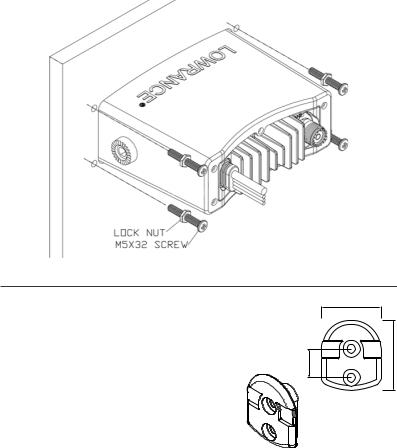
that will be covered by the radio fascia after installation.) Drill the 4 mounting holes.
3.Remove the installation template and slide the radio into the cavity.
4.Screw each M5x32 screw through the screw hole in the mounting bracket, then attach the stopper. If your bulkhead exceeds 0.51” (13mm), the stopper can be discarded if necessary.
5.Tighten the M5x32 screws until the radio is held firmly against the rear of the bulkhead.
Install the Microphone Bulkhead Mount
1.Hold the microphone bulkhead mount at the chosen location and use a soft pencil to mark the screw hole positions on the mounting surface. Ensure that the microphone curly cable will comfortably reach this location BEFORE you drill.
2.Drill the two pilot screw holes where marked.
3.Use a short length Philips screwdriver and the set of two flat screws, spring washers, plain washers, and nuts to secure the microphone bulkhead mount at the location site.
4.Hang the microphone on its mount.
|
MM |
MM |
MM |
Lowrance - LVR-250 Installation and Operation Instructions |
9 |
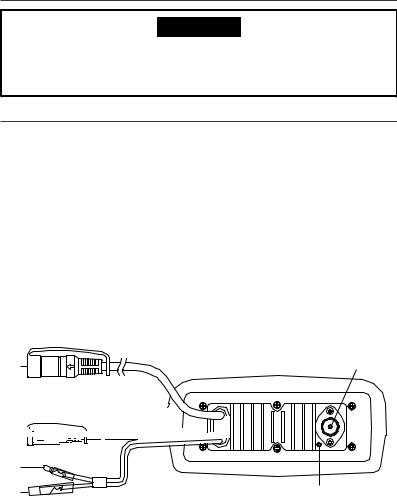
Fix the DSC label
 CAUTION
CAUTION
A DSC warning label is supplied with the LVR-250. To comply with FCC regulations, this warning label must be affixed in a location that is clearly visible from the operating controls of this Lowrance radio. Make sure that the chosen location is clean and dry before applying this label.
Connect the Radio Cables
The connectors are on the rear of the base unit, as follows:
1.GPS/COM connector. For connection to GPS device via NMEA. See the following table for wiring and color codes. (If you’re not using this, be sure to put the protective cap securely over the connector to protect it from moisture and dust.)
2.External Speaker connector. Plug the external speaker cable jack into the connector BEFORE powering on the radio. Use a 4 Ohm 4 Watt external speaker.
3.Red Power wire. Connect this to the Positive (+) battery terminal. Check that a 10 Amp fuse is installed on this power cable close to the battery.
4.Black Power wire. Connect this to the Negative (-) battery terminal.
5.ANT. A radio antenna is not supplied. A suitable radio antenna must be mounted and connected before operating the LVR-250 radio. Consult your dealer for advice if necessary.
6.GND. A ground connection is not usually required.
1 |
5 |
2 






3
4 |
6 |
10 |
Lowrance - LVR-250 Installation and Operation Instructions |
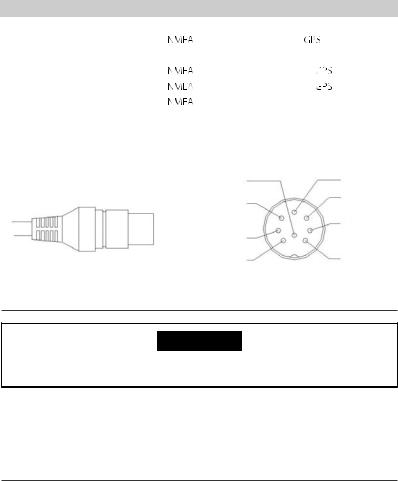
Wiring for GPS/COM connector
Pin |
Wire |
Function |
Notes |
|
1 |
Red |
No connection |
(Not used) |
|
2 |
Orange |
OUT (+) |
(To |
) |
3 |
White |
Program/clone |
(Not used) |
|
4 |
Green |
IN (-) |
(From |
) |
5 |
Yellow |
IN (+) |
(From |
) |
6 |
Black |
OUT (-) |
(Ground) |
|
7 |
Blue |
No connection |
(Not used) |
|
8 |
Grey |
No connection |
(Not used) |
|
8 Grey |
2 Orange |
|
5 Yellow |
4 Green |
|
|
|
|
|
1 |
Bare wire |
3 White |
|
|
7 Blue |
6 |
Black |
Set Up the Radio
 CAUTION
CAUTION
You can’t make any DSC transmissions until you’ve obtained a user MMSI and entered it into your LVR-250.
The user MMSI is a unique nine digit number, similar to a personal telephone number. It is used on marine transceivers that are capable of using DSC (Digital Select Calling).
If you don’t have a user MMSI contact the appropriate authorities in your country. If you’re unsure who to contact, consult your Lowrance dealer.
Enter Your User MMSI
Refer to 4.2 Enter your user MMSI.
Lowrance - LVR-250 Installation and Operation Instructions |
11 |
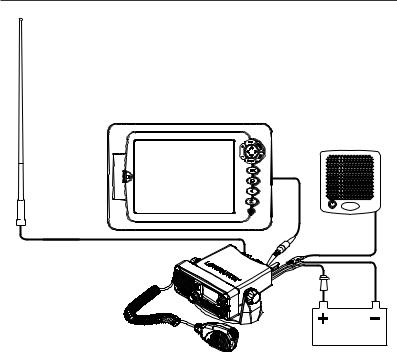
The Completed Installation
|
|
External |
|
|
speaker |
GPS product |
|
|
VHF Antenna |
|
|
|
External speaker |
|
|
|
connection |
Antenna connection cable |
|
cable |
|
Fuse |
Black |
|
power |
|
|
on Red |
|
|
cable |
|
|
power |
|
|
|
|
|
cable |
Battery |
|
|
|
Base unit with |
|
|
microphone |
|
|
12 |
Lowrance - LVR-250 Installation and Operation Instructions |

Notes:
Lowrance - LVR-250 Installation and Operation Instructions |
13 |

Section 1 - General Information
1-1 Features
Congratulations on your purchase of a Lowrance LVR-250 marine band VHF radio. It provides the following useful features:
•Prominent channel display
•Adjustable contrast settings for the LCD
•Adjustable keypad backlighting for easy night-time use
•Waterproof and submersible to comply with JIS-7
•GPS latitude and longitude (LL) and time display (when connected to a GPS)
•Choice of High or Low (25 W or 1 W) transmission power
•Top centred PTT button for comfortable leftor right-handed use
•Powerful 4 W external audio output
•Access to all currently-available marine VHF channel banks (USA, Canada, International) including weather channels where available
•Special CH16 or CH16/9 key for quick access to the priority (international distress) channel
•Special 3CH key to select your three favourite channels
•PSCAN (similar to dual watch) facility
In addition, the LVR-250 US/EU models also provide:
•DSC (Digital Select Calling) capability that meets USCG SC101/Class D Standards. LVR-250 US only.
•DSC (Digital Select Calling) capability that meets EC Class D Standards. LVR-250 EU only.
•DISTRESS call button to automatically transmit the MMSI and position until an acknowledgement is received
•Easy access to a buddy list of up to 20 favourite people
•MMSI storage for three favourite groups
•Group Call and All Ships Call facility
•LL position polling information
•Weather alert facility where available. LVR-250 US only.
•ATIS facility for inland waterways. LVR-250 EU only.
14 |
Lowrance - LVR-250 Installation and Operation Instructions |

1-2 Customizing your Lowrance VHF Radio
You can customize the radio to suit your individual preferences. Some preferences can be set directly through the keys as explained in this Section.
Other preferences are set up through the built-in menus and these are explained in the other Sections.
1-3 How to Display and Navigate Menus
1.Press MENU (or CALL). Note that only three menu items can be displayed at any one time on the screen.
2.Rotate the Rotary knob, or use + / - keys on the microphone to scroll up and down the menu until the cursor is positioned at the desired option. Press ENT (press the Push To Select) to display that option.
3.Make any entries or changes as explained in the following section.
4.Press ENT to confirm changes. Otherwise, press EXIT to keep the original entry.
5.Press EXIT to backup one screen (this key is equivalent to an ESC function on a PC)
1-4 How to Enter Alphanumeric Data
If your radio does not have the optional alphanumeric microphone, you can Rotate the Rotary knob, or use + / - keys on the microphone key to enter alphanumeric data.
Press - to count through numbers, or hold down to scroll rapidly to the desired number.
Press + to step through the alphabet, or hold down to scroll rapidly to the desired character.
If you make an error, press - until < is displayed, then press ENT to backup and correct the entry.
1-5 LCD Symbols and Meanings
Lowrance - LVR-250 Installation and Operation Instructions |
15 |

This simulation shows the locations of all the following information symbols:
Symbol |
Meaning |
|
TX |
Transmitting. |
|
HI LO |
Transmission power. High (HI) 25W or Low (LO) 1W. |
|
WX |
Weather channel. LVR-250 US only. |
|
WX ALT |
Weather Alert. Alarm beeps will sound. LVR-250 US only. |
|
BUSY |
Receiver busy with an incoming signal. |
|
PRI |
Priority channel is selected. |
|
D |
Duplex operation. Otherwise, blank for Simplex operation. |
|
LOCAL |
Local calling is selected. Otherwise, blank for distance calling. |
|
DSC |
DSC capability is available. |
|
|
|
Incoming DSC call. |
|
|
Low Battery warning (activates at 10.5 V). |
|
|
|
|
|
Channel selected. |
USA INT CAN |
Selected channel bank for VHF radio operations and regulations. |
|
X |
Channel is temporarily deleted from the ALL SCAN operation. |
|
B A |
Channel suffix, if applicable. |
|
CH1 CH2 CH3 |
Shows which of the 3 favourite channels, if any, are selected. |
|
|
|
Otherwise blank. |
ATIS |
LVR-250 EU only, and enabled for radios in European inland waterways. |
|
A typical operational display is shown here.
The latitude and longitude of the vessel and the local time are shown.
A transmission on Channel 16 is being made at high power using the International channel bank.
Channel 16 is set as the Priority channel. It is also set as favourite channel 1. There is an incoming DSC call so the receiver is busy.
16 |
Lowrance - LVR-250 Installation and Operation Instructions |
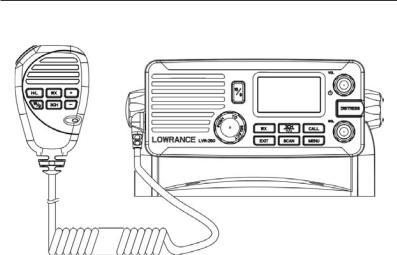
1-6 Basic Operation and Key Functions
All possible keys and their functions are listed here. Note that some of the keys may not be available depending on your Lowrance VHF radio model.
Key |
Function |
VOL/PWR |
Volume and Power. Turn clockwise to power on. Continue to turn until a |
|
comfortable volume is reached. VOL/PWR will also adjust the settings of an |
|
external speaker, if connected. |
SQL |
Squelch or Threshold Level. Sets the threshold level for the minimum |
|
receiver signal. Turn fully counterclockwise until random noise is heard, |
|
then turn slowly clockwise until the random noise disappears. |
|
Make another 1/4 turn clockwise for best reception in open sea |
|
conditions. |
|
In areas of high noise (eg close to large cities) reception may improve if |
|
sensitivity is reduced. Either turn SQL slowly clockwise or use the LOCAL |
|
setting. See section 2.3. |
16/9 |
Priority Channel. Also on the microphone. Press to cancel all other |
|
modes and to tune into the priority channel. Press again to return to your |
|
original channel. |
|
The default is Channel 16. To make Channel 09 the priority channel, hold |
|
down 16/9 until a beep sounds and 09 is displayed. |
16Priority Channel. LVR-250 EU only. Also on the microphone. Press to cancel all other modes and to tune into the priority channel. Channel 16, on high power. Press again to return to your original channel.
Lowrance - LVR-250 Installation and Operation Instructions |
17 |
WX |
Weather Channel. LVR-250 US only. In USA and Canadian waters, |
|
press to hear the most recently selected weather station. The WX symbol is |
|
displayed on the LCD. |
|
Rotate the dial or + / - on the microphone to change to a different |
|
weather channel. Press WX again to return to the most recent channel. |
|
If the weather alert mode (ALT) is ON and an alert tone of 1050Hz is |
|
broadcast from the weather station, it is picked up automatically and the |
|
alarm sounds. Press any key to hear the weather alert voice message. |
H/L |
Transmission Power. (Located on the microphone). High (HI) 25W or Low |
|
(LO) 1W. Press to toggle between high or low transmission power for the |
|
entire channel bank. The HI or LO selection is shown on the LCD. |
|
Some channels allow only low power transmissions. Error beeps will sound |
|
if the power transmission setting is incorrect. |
|
Some channels allow only low power transmissions initially, but can be |
|
changed to high power by holding down H/L and PTT at the same time. |
|
See Appendix C for a complete listing of channel charts. |
3CH |
Three Favourite Channels. Also on the microphone. Press to toggle |
|
between your favourite channels. The CH1, CH2, or CH3 symbol appears on |
|
the LCD to show which favourite channel is selected. |
|
To scan only one of your favourite channels, press 3CH then immediately |
|
press and release SCAN. If you want to scan all three favourite channels, |
|
press 3CH then immediately press and hold SCAN. |
|
To add a favourite channel for the first time, select that channel then hold |
|
3CH to store it in the CH1 location. Repeat the procedure to store two more |
|
favourite channels in the CH2 and CH3 locations respectively. |
|
If you try and add another favourite channel it will overwrite the existing |
|
CH3. CH1 and CH2 remain unless you delete them. |
|
To delete a favourite channel, select that channel then hold down 3CH until |
|
the CH1, CH2 or CH3 symbol disappears off the LCD. |
SCAN |
Scan. Press to scan between your current channel and the priority channel |
|
in DUAL or TRI WATCH mode. The weather channel is also scanned if the |
|
USA channel bank is selected and the weather alert mode (ALT) is ON. |
|
Hold down SCAN to enter ALL SCAN mode where the priority channel is |
|
checked every 1.5 seconds. |
|
When a signal is received, scanning stops at that channel and BUSY ap- |
|
pears on the screen. If the signal ceases for more than 5 seconds, the scan |
|
restarts. |
|
Press ENT to temporarily skip over (lock out) an “always busy” channel when |
|
in ALL SCAN mode and resume the scan. An X is shown on the screen to |
18 |
Lowrance - LVR-250 Installation and Operation Instructions |
designate a skipped channel. Note that it is not possible to skip over the priority channel.
Press SCAN to stop at the current channel.
PUSH TO SELECT Enter (ENT). Use ENT when navigating menus, to confirm entries and edits.
EXIT Escape (ESC). Use EXIT when navigating menus, to clear incorrect entries, to exit from a menu without saving changes, and to back up to the previous screen.
CALL |
Radio and DSC Call Menu. Press to enter the DSC Call Menu and make |
|
DSC calls. See Section 6. |
MENU |
DSC Setup Menu. Press to enter the DSC Setup Menu and to customize |
|
your radio. See Section 2-5. |
DISTRESS |
Send DSC Distress Call. See Section 6. |
PTT |
Press To Talk. (located on the microphone). Press PTT to transmit at any |
|
time on an allowable channel. This automatically exits you from menu |
|
mode and stops scanning. You must release PTT to receive a signal. |
|
If PTT sticks, a built-in timer will automatically shut down a transmission |
|
after five minutes and sound the error beeps. |
Rotary knob |
Channel Select. Turn to select a channel. The current channel is shown |
|
on the LCD in BIG digits an A or B designator suffix (if applicable) in small |
|
letters below the channel number. (See appendix C for a listing of channel |
|
frequencies). |
|
Push to activate the ENT function. |
|
You can also use the rotary knob for alphanumeric entry. Turn to step |
|
through alphanumeric characters one at a time then push to confirm each |
|
selection. If you make an error, select the < character then push to backup. |
+ / - |
Channel Select. (Located on the microphone). The current channel is |
|
shown on the screen in BIG digits with an appropriate designator suffix A or |
|
B in small letters below the channel number. |
|
Press + or - to step through the available channels one at a time, or hold |
|
down to scroll rapidly through all the available channels. See Appendix C |
|
for a listing of channel charts. |
|
Alphanumeric Entry. This key can also be used for menu selection and |
|
for alphanumeric entry. Press + or - to scroll the cursor up or down menu |
|
options when navigating menus. |
|
When editing an item containing only numbers, press - to count through |
|
the numbers or hold down to scroll rapidly. |
|
To enter a character, press + to step through the alphabet or hold down to |
|
scroll rapidly. |
Lowrance - LVR-250 Installation and Operation Instructions |
19 |

Section 2 - The Radio Menu (MENU)
2-1 Radio Menu Options (Menu)
The following options are available through MENU key:
BUDDY LIST LOCAL/DIST BACKLIGHT CONTRAST
GPS/DATA
DSC SETUP
RADIO SETUP
GPS SIM
RESET
MANUAL
SETTING
USER MMSI GROUP SETUP INDIV REPLY ATIS MMSI ATIS FUNC DSC FUNC
LL REPLY
UIC
CH NAME RING VOLUME KEY BEEP
INT SPEAKER WATCH MODE WX ALERT COM PORT
Maintain your buddy list.
See Section 2-2.
Set radio sensitivity.
See Section 2-3.
Set backlight level.
See Section 2-4.
Set contrast level.
See Section 2-4.
Set position & UTC manually.
See Section 2-5.
Set local time and time format.
See Section 2-5.
DSC Setup Menu.
See Section 4.
Make DSC calls.
See Section 5.
Radio Setup Menu.
See Section 3.
Turn the GPS Simulator on/off.
See Section 2-6.
Reset factory settings.
See Section 2-7.
Sections 1-3 and 1-4 explain how to navigate around the menu and enter, save and change data.
20 |
Lowrance - LVR-250 Installation and Operation Instructions |
